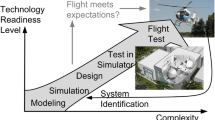Abstract
RED-UAS 2011 paper. When designing new control techniques for unmanned helicopters, the development of mathematical models that reproduce the dynamics of the real platform is a matter of importance. This allows the usage of model-based approaches that achieve better adaptation of the control laws to the real system. In these cases, the objective is not to obtain complex equations like those required for high-fidelity simulations. Instead, the aim is to derive simple and manageable models that ease the derivation of the control laws, maintaining at the same time their capability to reproduce the main behavior of the real system. The dynamics of a small-size helicopter with a stiff main rotor are mainly described by its mechanical model. Accordingly, this paper analyzes in detail three representative methods for elaborated modeling of the mechanics of small-size helicopters: Newton–Euler, Lagrange and Kane. For that purpose, the most general case is considered: two rigid bodies, fuselage and main rotor. As a consequence, the resulting models account for most significant modeling issues in the mechanical behavior of a small-size helicopter, such as the gyroscopic effect. Although the equations obtained using the three approaches are equivalent in the sense that they generate the same numerical results in simulation, Kane’s method holds some unique advantages.
Similar content being viewed by others
References
Baruh, H.: Analytical Dynamics. McGraw Hill, New York (1998)
Baruh, H.: Another look at the describing equations of dynamics. J Chin Soc Mech Eng Trans Chin Inst Eng 21(1), 15–23 (2000)
Borri, M., Bottasso, C., Mantegazza, P.: Equivalence of Kane’s and Maggi’s equations. Meccanica 25(4), 272–274 (1990)
Kane, T.R., Levinson, D.A.: Dynamics, Theory and Applications. McGraw Hill, New York (1985)
Kane, T.R., Likins, P.W., Levinson, D.A.: Spacecraft Dynamics. McGraw Hill, New York (1983)
Kondak, K., Bernard, M., Losse, N., Hommel, G.: Elaborated modeling and control for autonomous small size helicopters. VDI-Ber. 1956, 207–216 (2006)
Kondak, K., Bernard, M., Meyer, N., Hommel, G.: Autonomously flying VTOL-robots: modeling and control. In: IEEE International Conference on Robotics and Automation, pp. 736–741 (2007)
Motiongenesis Kane 5.x.: Forces, motion and codegeneration software. http://www.motiongenesis.com/ (2012). Accessed June 2012
Papastavridis, J.: A panoramic overview of the principles and equations of motion of advanced engineering dynamics. Appl. Mech. Rev. 51(4), 239–265 (1998)
Piedboeuf, J.: Kane’s equations or Jourdain’s principle? In: IEEE Midwest Symposium on Circuits and Systems, vol. 2, pp. 1471–1474 (1993)
Author information
Authors and Affiliations
Corresponding author
Rights and permissions
About this article
Cite this article
Sandino, L.A., Bejar, M. & Ollero, A. A Survey on Methods for Elaborated Modeling of the Mechanics of a Small-Size Helicopter. Analysis and Comparison. J Intell Robot Syst 72, 219–238 (2013). https://doi.org/10.1007/s10846-013-9821-y
Received:
Accepted:
Published:
Issue Date:
DOI: https://doi.org/10.1007/s10846-013-9821-y




